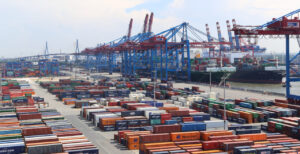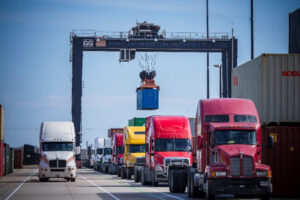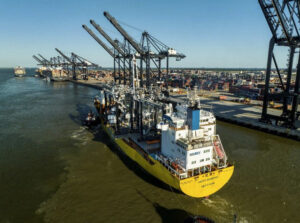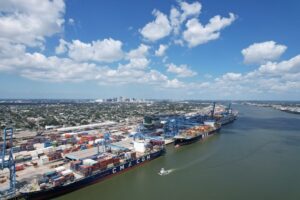In the first of a two-part blog for Port Technology, CEO and Managing Director of DP World Europe and Russia, Rashid Abdulla, reviews the new landscape of global trade.
The world around us is in a constant state of flux. With trade wars rumbling on, global consumption patterns ever-changing and our climate increasingly unpredictable, to say the future is uncertain is an understatement. Yet, as a result, there is one constant for businesses: the necessity to constantly adapt.
This couldn’t be any clearer than in the logistics sector, where the flow of goods and the needs of consumers require supply chain operators and businesses to constantly adjust and fine-tune their operations, making them leaner, more robust and flexible.
Dynamism, however, is not always a given when it comes to logistics. Having to rely on legacy infrastructure can, at times, be a drag, especially when shaving seconds off of distribution and delivery can be make-or-break in saturated markets.
Read a recent PTI Blog by DP World on the “Food Supply Chain”
With consumer demand for speedy delivery only increasing, and the sheer volume of goods being ordered also on the rise, businesses are having to bend over backwards to fulfil orders and keep customers happy.
Being tech-savvy is crucial in this fluctuating world. Take the arrival of voice-activated commerce, for instance, such as Amazon’s Alexa.
Voice shopping is still in its infancy but is set for exponential growth, and firms are already preparing for it. By 2020, half of all internet searches will be conducted by voice; in the UK and US alone, voice shopping is estimated to be worth over $40 billion by 2022.
Amid this growing strain and frenetic competition, there is a serious opportunity for businesses and their supply chain partners that are prepared to think differently about global trade.
This requires some self-reflection and a solutions-oriented approach that utilises the fluctuations both inside and outside the world of trade, understanding consumer patterns and combining emerging technologies to ensure that supply chains work for you and your customers.
Thriving in Complexity
What’s needed to fulfil both businesses and consumers’ growing array of demands is a genuinely end-to-end solution, which is what we’re trying to achieve at DP World.
For us, the seamless connection between our port terminals, the internal port operations and our inland logistics solutions ensures that businesses have a fully streamlined solution that is lean, fast and above all, tech-savvy.
The ballooning world of e-commerce offers insight into the complexity that many businesses are currently facing or are yet to.
PTI will soon be releasing Edition 85: Supply Chain Collaboration; subscribe today to read the issue
The omni-channel supply chain needed to fulfil the demands of e-commerce and online delivery is far more complex than the supply chains needed to stock and manage traditional brick-and-mortar retailers.
Flexibility and dynamism have to be baked in, with stock management across multiple distribution centres, warehouses and stores, all at a pace and with reverse logistics for the growing number of returns.
Returns – and those customers that return goods frequently – are ravaging the supply chain’s ability to cope with high volumes of reverse logistics. Some businesses are simply refusing to face this issue head-on, with e-commerce giants such as ASOS banning serial returners from sending back goods.
While ASOS’ move is understandable in terms of coping with the cost pressures of reverse logistics, the way in which e-commerce and consumption patterns are evolving means that firms need to build supply chain operations that can actually deliver reverse logistics, rather than isolating specific customers.
“Also referred to as the ‘Amazon effect’, the emergence of e-commerce is shifting consumer behaviour…” @portoflongbeach #PTIDaily #Amazon #eCommercehttps://t.co/WkyQlOROc0
— Port Technology (PTI) (@PortTechnology) February 13, 2019
The need for speed and flexibility is driving companies to outsource more and more of their manufacturing in order to go direct to the customer, with the intention of getting goods to the end-users at a much faster rate than traditional methods.
At the same time, the strain which fast delivery is putting on supply chain operators is causing them to have to aggressively manage their inventory portfolios to streamline their operations.
For many operators, they simply aren’t able to keep up, and in such a volatile market, an inability to sort, store and distribute in a timely fashion is the beginning of the end for a supply chain operator.
What Does This Mean for Logistics?
Alexa and her ilk are set to add another layer of complexity to supply chains. This added layer isn’t simply due to the volume increase of orders, but also the mass customisation of products and Amazon’s criteria that firms’ supply chains can guarantee items are in stock and can be delivered on time, with packaging that ensures goods are not damaged in transit.
When 85% of American smart speaker users say they have gone with their speaker’s top product recommendation rather than the one they set out to purchase, it’s all or nothing for businesses looking to gain a market share in e-commerce.
What’s more, this form of shopping is only set to grow as the majority of people using voice shopping are younger, more tech-literate consumers.
Despite the volatile and unpredictable demand that voice-activated commerce adds to the mix, businesses and their supply chains will be expected to keep up.
In practice, this entails smaller truckloads of customised goods, mixed pallets of inventory to reduce warehouse cost and a greater number of consolidation points close to key markets to improve the speed of delivery.
The arrival of voice ordering offers an opportunity to design and build supply chains that deliver in every regard.
This means achieving an ecosystem where a company produces its ideal product portfolio with the most collaborative supplier base, employing a perfect labour model and state-of-the-art production equipment, and delivering it via the customers’ optimal route.
Adam Gostling discusses how the industry can develop a digitally resilient supply chain in a recent Port Technology technical paper
Being an enabler of smart trade, DP World envisages this to be the future of global supply chains and is developing it assets and products to unlock value.
As a company, DP World now dedicates itself to helping customers move their wares around the world faster, safer, smarter and more cost-efficiently. The end game is to improve performance at all stages of the supply chain by using data-driven logistics and digital solutions – from point of manufacture to point of consumption.
Ultimately, this gives cargo owners visibility and control as their goods are transported to the market, accounting for the fact that today, the supply chain is also a demand chain.
When we look at Alexa and her smart-speaker siblings, this fact couldn’t be clearer. The penetration rates of smart-speakers into households, and the growing ease at which consumers are using them, indicate a shift beyond e-commerce into the realms of a-commerce: automated commerce.
Surveys show that when asked if they want choice or convenience, most consumers will say both, at different times and for different products.
In each and every one of these purchasing situations, one of these factors will be more important than the other, requiring agile, flexible and on-demand assets that can help companies keep their customers happy with both choice and convenience.
Wolfgang Lehmacher discusses the innovation of ports-as-an-app platforms in a recent Port Technology technical paper
This shift in the sector means that many businesses are trying to be asset-light, especially on the digital freight forwarders side, with the likes of Freighthub, Flexport and even Maersk Logistics looking to increase agility.
As such, supply chain and terminal operators need to provide both the physical assets and infrastructure for this new fleet of asset-light businesses to use, hire and purchase services from, while ensuring speed and flexibility.
For us, this is the brave new world in which logistics providers must operate. And it’s only through an end-to-end solution, which is digitally-enabled, that supply chains can keep up with the demands of global trade.
Rashid Abdulla:
Rashid Abdulla is a business leader with a wealth of experience spanning over 20 years in the maritime industry and is the CEO of DP World Europe and Russia.
Mr Abdulla was most recently chief executive and managing director for DP World’s Asia Pacific region and chairman of Asian Terminals Inc, its operation in Manila, managing business units in China, Korea, and south-east Asia for four years.
His previous roles include senior vice president for global operations at DP World Head Office in Dubai, and COO for DP World’s flagship Jebel Ali Port.












